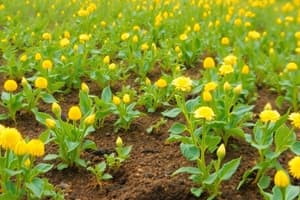Podcast
Questions and Answers
What does the Plasticity Index (PI) indicate about the soil?
What does the Plasticity Index (PI) indicate about the soil?
Which method of compaction involves dropping heavy weights from a height to densify soil?
Which method of compaction involves dropping heavy weights from a height to densify soil?
Which factor does not directly influence the shear strength of soil?
Which factor does not directly influence the shear strength of soil?
What is the process of volume reduction in saturated soil due to the expulsion of water under load called?
What is the process of volume reduction in saturated soil due to the expulsion of water under load called?
Signup and view all the answers
Which test is used to measure shear strength under controlled conditions?
Which test is used to measure shear strength under controlled conditions?
Signup and view all the answers
What does the moisture content refer to in soil properties?
What does the moisture content refer to in soil properties?
Signup and view all the answers
Which of the following methods of compaction uses vibration to rearrange soil particles?
Which of the following methods of compaction uses vibration to rearrange soil particles?
Signup and view all the answers
Which concept explains the ongoing volume changes due to soil particle rearranging over time?
Which concept explains the ongoing volume changes due to soil particle rearranging over time?
Signup and view all the answers
What does the Void Ratio measure in soil?
What does the Void Ratio measure in soil?
Signup and view all the answers
According to the Mohr-Coulomb Failure Criterion, shear strength is calculated as which of the following?
According to the Mohr-Coulomb Failure Criterion, shear strength is calculated as which of the following?
Signup and view all the answers
Study Notes
Soil Properties
- Texture: Refers to the size distribution of soil particles; classified as sand, silt, clay.
- Plasticity: Ability of soil to deform without cracking; indicated by the Plasticity Index (PI).
- Permeability: Measure of how easily water can flow through soil; influenced by soil texture and structure.
-
Density:
- Bulk Density: Mass of soil per unit volume, including voids.
- Dry Density: Mass of soil per unit volume excluding water.
- Moisture Content: Ratio of water weight to dry soil weight; affects strength and compressibility.
- Void Ratio: Measure of void space in soil; ratio of volume of voids to volume of solids.
Compaction Techniques
- Purpose: Increases soil density, reduces voids, and improves load-bearing capacity.
-
Methods:
- Static Compaction: Utilizes heavy weights to compress soil.
- Dynamic Compaction: Involves dropping heavy weights from a height to densify soil.
- Vibratory Compaction: Uses vibration to rearrange soil particles, improving density.
- Water or Air Pressure: Can be used for soil stabilization and compaction.
- Proctor Test: Determines optimal moisture and compaction levels for soil.
Shear Strength
- Definition: Resistance of soil to shear stress; crucial for stability of soil structures.
-
Factors Influencing Shear Strength:
- Cohesion: Inter-particle forces; significant in clay soils.
- Internal Friction Angle: Resistance to sliding, influenced by grain size and shape.
-
Mohr-Coulomb Failure Criterion:
- Shear strength (τ) = c + σ tan(φ)
- Where c = cohesion, σ = normal stress, φ = internal friction angle.
-
Laboratory Tests:
- Triaxial Test: Measures shear strength under controlled conditions.
- Unconfined Compression Test: Evaluates strength without lateral confinement.
Consolidation
- Definition: Process of volume reduction in saturated soil due to expulsion of water under load.
-
Key Concepts:
- Primary Consolidation: Immediate reduction in volume due to water drainage.
- Secondary Consolidation: Ongoing volume changes due to soil particles rearranging over time.
- Coefficient of Consolidation (Cv): Measures the rate at which consolidation occurs; affected by permeability and compressibility.
-
Consolidation Tests:
- Oedometer Test: Measures vertical deformation under controlled loading.
- Importance: Critical for predicting settlement in foundations and structures.
Soil Properties
- Texture: Defines the size distribution of soil particles; categorized as sand, silt, or clay.
- Plasticity: Indicates soil's ability to deform without cracking, represented by the Plasticity Index (PI).
- Permeability: Assesses water flow through soil; depends on both soil texture and structure.
-
Density:
- Bulk Density: Represents mass of soil per unit volume, including all voids.
- Dry Density: Mass of soil per unit volume that excludes water content.
- Moisture Content: Ratio comparing the weight of water to the weight of the dry soil; impacts soil strength and compressibility.
- Void Ratio: Indicates the void space in soil, calculated as the ratio of void volume to the volume of solids present.
Compaction Techniques
- Purpose: Enhances soil density, minimizes voids, and boosts load-bearing capacity.
-
Methods:
- Static Compaction: Compresses soil using heavy weights.
- Dynamic Compaction: Achieved by dropping weights from a height to increase soil density.
- Vibratory Compaction: Enhances density through vibration that rearranges soil particles.
- Water or Air Pressure: Employed for stabilization and compaction of soil.
- Proctor Test: Utilized to ascertain optimal moisture content and compaction levels necessary for the soil.
Shear Strength
- Definition: Measures soil's resistance to shear stress, essential for the stability of soil structures.
-
Influencing Factors:
- Cohesion: The inter-particle forces, particularly influential in clay soils.
- Internal Friction Angle: Reflects the soil's resistance to sliding, affected by particle size and shape.
- Mohr-Coulomb Failure Criterion: Expresses shear strength as τ = c + σ tan(φ) where c is cohesion, σ is normal stress, and φ is the internal friction angle.
-
Laboratory Tests:
- Triaxial Test: Assesses shear strength under controlled laboratory conditions.
- Unconfined Compression Test: Evaluates strength without the application of lateral confinement.
Consolidation
- Definition: Involves the reduction of volume in saturated soil as water is expelled under load.
-
Key Concepts:
- Primary Consolidation: Immediate volume reduction resulting from water drainage.
- Secondary Consolidation: Ongoing volume adjustments due to reconfiguration of soil particles over time.
- Coefficient of Consolidation (Cv): Indicates the rate of consolidation, influenced by both soil permeability and compressibility.
-
Consolidation Tests:
- Oedometer Test: Measures vertical deformation in soil under controlled loading conditions.
- Importance: Essential for predicting potential settlement in foundations and other structures.
Studying That Suits You
Use AI to generate personalized quizzes and flashcards to suit your learning preferences.
Description
Test your understanding of key soil properties such as texture, plasticity, and permeability, along with various compaction techniques used to improve soil density. This quiz covers essential concepts critical for soil mechanics and engineering applications.




